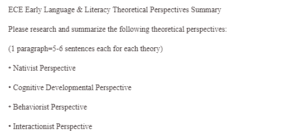ECE Early Language and Literacy Theoretical Perspectives
The paper discusses how four theoretical perspectives (behavioral theory, nativist theory, cognitive developmental theory, and interactionist theory) are practically applied to the curriculum content. Firstly, each theoretical perspective is briefly summarized. Then, a classroom activity aligned with each theory is demonstrated. The behaviorist theory suggests a gradual language acquisition process from imitation to reinforcement, with the material being learned in small units and the teacher checking students’ work regularly and providing feedback. The nativist theory centers on our innate ability to learn languages and deduce rules ourselves based on numerous examples. The cognitive developmental perspective concentrates on mental or cognitive development changes alongside stage development. The interactionist theory involves learning as a two-way communication process and negotiating, expressing, and clarifying students’ thoughts to achieve mutual understanding.
Keywords: behavioral theory, nativist theory, cognitive developmental theory and interactionist theory, classroom activities.
Applying Theoretical Perspectives to Curriculum Content
The paper focuses on how behaviorist, nativist, cognitive developmental, and interaction- ist theories apply to the curriculum content regarding language acquisition.
The behaviorist theory in language acquisition is based on a gradual language acquisition process from imitation to reinforcement (Demirezen, 1988), so the material is learned in small units. Moreover, a teacher checks students’ work regularly and provides feedback on their performance (reward and reinforcement). The examples of classroom activities aligned with the behavioral theory are those connected with phonetic skills development. Firstly, students imitate sounds or intonation patterns after the teacher, then repeat sounds in chorus and individually. After that comes the stage of memorization of how to pronounce sounds in certain words. Then, the teacher supplies students with controlled drilling, followed by reinforcement. Such activities are preferable at an early stage of language acquisition (elementary school).
The nativist theory suggests a person’s innate ability to learn languages thanks to a language acquisition device installed in her brain. So, languages should be acquired without direct instruction and understanding rules (Escamilla, Grassi, 2000). Keeping this in mind, Chomsky invented the transformational grammar theory, which focuses on language acquisition rather than the formation of habits and is based on the rules that learners deduce for themselves. This theoretical perspective can be applied to learning grammar using inductive learning, when students are shown examples that they analyze and then discover and formulate grammar rules themselves. For example, the target grammar structures are the Past Simple and the Past Progressive. Firstly, students are given a mini-task: They are asked to describe the occasion when they met an important person in their life and say what they were doing and wearing and what was happening. Then, students listen to how a man met his future wife (the story is packed with the target grammar structures) and do comprehension check tasks. After that, students read the story and choose the correct tense from the target grammar structures. The next stage is analyzing how these grammar structures are formed and used. Students formulate rules for using both structures and focus on the intersection of their use. Finally, students are offered exercises to use these grammar structures on the sentence level and then on the text level.
The cognitive developmental theory suggests that children undergoing certain developmental stages also have certain mental or cognitive development changes, including acquiring, storing, and retrieving knowledge for solving problems (Gillani). That is why discovery learning was developed, as it emphasizes exploring, experimenting, and doing research. Classroom activities within discovery learning can be used at various developmental stages; the thing that differs is the task and material used in the activity. An example of the “problem” that students should solve is finding an ideal place to live for a family of four (with jobs and level of income indicated) with a 14-year-old son and a 7- 7-year-old daughter who will start school. The teacher is supposed to indicate any other details and provide students with information about possible accommodation. Students can first be offered to identify the problem, formulate the hypothesis, collect and analyze data, and conclude (Gillani).
The interactionist perspective of language learning presupposes that students should be involved in meaningful activities in which they are compelled to negotiate, express, and clarify their opinions to achieve mutual understanding (Ariza, Hancock 2003). An example of a classroom activity can be a task when students first work in small groups, decide on a certain subject, and then, while working with other groups, have to arrive at a common decision by using negotiating techniques.
Link to the mindmap: https://www.mindmeister.com/128884554
References
Ariza, E. N., Hancock, S. (2003 October) Second Language Acquisition Theories as a Framework for Creating Distance Learning Courses. The International Review of Research in Open and Distance Learning. Retrieved from http://www.irrodl.org/index.php/irrodl/article/view/142/222
Demirezen, M. (1988) Behaviorist Theory and Language Learning. Hacettepe Üniversitesi Eğitim Fakültesi Dergisi. Sayı 3, 135 – 140. Retrieved from http://www.efdergi.hacettepe.edu.tr/19883MEHMET%20DEM%C4%B0REZEN.pdf
Escamilla, K., Grassi, E. (2000) A Brief Description of Second Language Acquisition. The Professional Development Resource Series, “Second Language Acquisition,” BUENO Center, University of Colorado, Boulder. Retrieved from http://www.wce.wwu.edu/Resources/CIRCLE/Articles/SLA%20Escamilla+Grassi.pdf
Gillani. Chapter 4. Cognitive Theories and Constructive Learning Environments. Retrieved from http://edschool.csueastbay.edu/departments/etleads/Chapter4Cognitive.PDF
ORDER A PLAGIARISM-FREE PAPER HERE
We’ll write everything from scratch
Question
ECE Early Language & Literacy Theoretical Perspectives Summary

ECE Early Language and Literacy Theoretical Perspectives
Please research and summarize the following theoretical perspectives:
(1 paragraph=5-6 sentences each for each theory)
• Nativist Perspective
• Cognitive Developmental Perspective
• Behaviorist Perspective
• Interactionist Perspective

